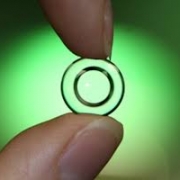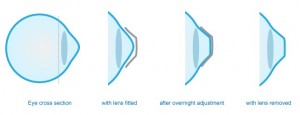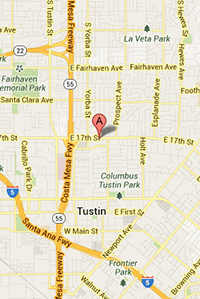Overnight Vision Correction
Wouldn’t it be great if you could correct your eyesight and reduce your dependence on glasses or contact lenses — without having to undergo eye surgery? Orthokeratology (ortho-k) is the fitting of specially designed gas permeable (GP) contact lenses that you wear overnight. While you are asleep, the lenses gently reshape the front surface of your eye (cornea) so you can see clearly the following day after you remove the lenses when you wake up. GP contact lenses are not the same as the soft contact lenses that you may already wear; instead they are made of a firm, durable plastic that transmits oxygen.
How does an Ortho-K lens work?
The central portion of the lens fits closer to the eye than a standard contact lens exerting a gentle pressure. The outer part of the lens surrounds the central visual zone and is farther away from the cornea, allowing room for the cornea to change shape:
Ortho-K lenses are custom made for each individual, but not everyone qualifies for this corneal refractive therapy. Two important factors that determine the candidacy for orthokeratology includes the curvature of the eye and the prescription. Your eye care practitioner will measure the exact shape of your cornea and prescribe lenses with the curvature, size, and corrective power that suit your eyes. Ortho-k is recommended for low to mild nearsightedness (-5 diopters or less).
When you begin to wear ortho-k lenses, you will likely have mild awareness of the lenses on your eyes until you fall asleep. Because the corneal reshaping effect is temporary, little risk is involved, and you can discontinue wearing the lenses at any time.
In summary: no glasses, no daytime contacts, no surgery, 20/20 vision…no kidding!
Blog contribution by Eric Saidi, Optometry Intern, College of Optometry, Western University of Health Sciences.




